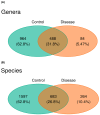Preliminary Study to Understand the Role of Gut Microbiota in Coronary Slow Flow Phenomenon (CSFP)
- PMID: 40710575
- PMCID: PMC12298151
- DOI: 10.3390/metabo15070475
Preliminary Study to Understand the Role of Gut Microbiota in Coronary Slow Flow Phenomenon (CSFP)
Abstract
Background/Objectives: Coronary slow flow phenomenon (CSFP) is a cardiovascular condition characterized by delayed passage of contrast medium through the coronary arteries, predominantly affecting young male smokers admitted with acute coronary syndrome. Although over 80% of patients experience recurrent chest pain and more than 20% require readmission, the etiology of CSFP remains poorly understood. Given the emerging role of gut microbiome in cardiovascular diseases, this study investigates the microbial composition associated with CSFP. Methods: Stool samples were collected from patients diagnosed with CSFP and healthy control individuals. Microbiota profiling was performed using 16S rRNA sequencing. Taxonomic differences were evaluated to identify microbial markers potentially associated with CSFP. Results: The analysis revealed a notable enrichment of the genus Gemmiger and the species Anaerobutyricum in CSFP patients, specifically within the selenium metabolism pathway. This is of particular interest given the established link between selenium deficiency and heightened cardiovascular risk, suggesting a possible microbiome-mediated modulation of selenium bioavailability in CSFP pathophysiology. Moreover, a marked increase in taxa associated with the biosynthesis of trimethylamine (TMA), a proatherogenic metabolite implicated in the onset and progression of various cardiovascular disorders, was observed in the CSFP cohort, further supporting a potential mechanistic role of gut microbiota in the disease's underlying etiology. Conclusions: Although statistical significance could not be established due to the limited sample size, the observed trends support the hypothesis that specific gut microbes and metabolic pathways, particularly those linked to selenium metabolism and TMA production, may serve as potential microbial indicators for CSFP. These preliminary findings warrant further investigation in larger cohorts.
Keywords: coronary health; coronary slow flow phenomenon; microbiome.
Conflict of interest statement
The authors declare no conflicts of interest.
Figures






References
-
- Vane J.R., Botting R.M. Secretory functions of the vascular endothelium. J. Physiol. Pharmacol. 1992;43:195–207. - PubMed
LinkOut - more resources
Full Text Sources

